
|
Judging by the volume and diversity of his extant coins, Menander I, often identified by the epithet "Soter" to distinguish him from Menander II, must have had a large
kingdom and a long reign. It appears he ruled only south of the Hindu Kush; his very rare Attic weight coins, known only in gold stater and silver tetradrachm denominations,
were probably ceremonial issues that recalled the possibility or memory of a Bactrian kingdom.
The dates of Menander are still not entirely clear. It seems he followed Apollodotus I and Antimachus II, particularly the latter, as it seems that his earliest issues carried the
same monograms as did the coins of Antimachus II. Since Menander depicted Athena on his coins, as did Apollodotus I, it seems reasonable to speculate (this is just my
theory) that Menander had a family relationship to Apollodotus I. Perhaps he was his son or younger brother. Antimachus II, on the other hand, issued coinage with no obvious
links to any previous ruler. He depicted Nike on his coins, a deity not featured by any previous Greek king in India, and this suggests to me that he was a usurper, who
attained his position by conquest (Nike being the goddess of victory). It is possible that Menander was commissioned by Apollodotus I to deal with this rebel, which his use of
Antimachus's mint monograms suggests he was able to do. Menander must have been roughly contemporary to Eucratides I, who was ruling at this time in Bactria, and the
two may have clashed south of the Hindu Kush as Eucratides attempted to make inroads there.
Menander is the only Greek king to have a clear mention in the Indian literary sources, as he is surely the King Milinda in the Buddhist text, the Milindapanha, which
purports to be a dialogue between King Milinda and the Buddhist sage Nagasena. This text has been taken by many to be evidence that Menander became a Buddhist, but
this may be purely speculative and reflect propagandizing by the Buddhist authors of the text ... there is little if any evidence from Menander's coins that he changed his beliefs
in any way.
|
| Menander I Soter |
Attic Standard Coins |
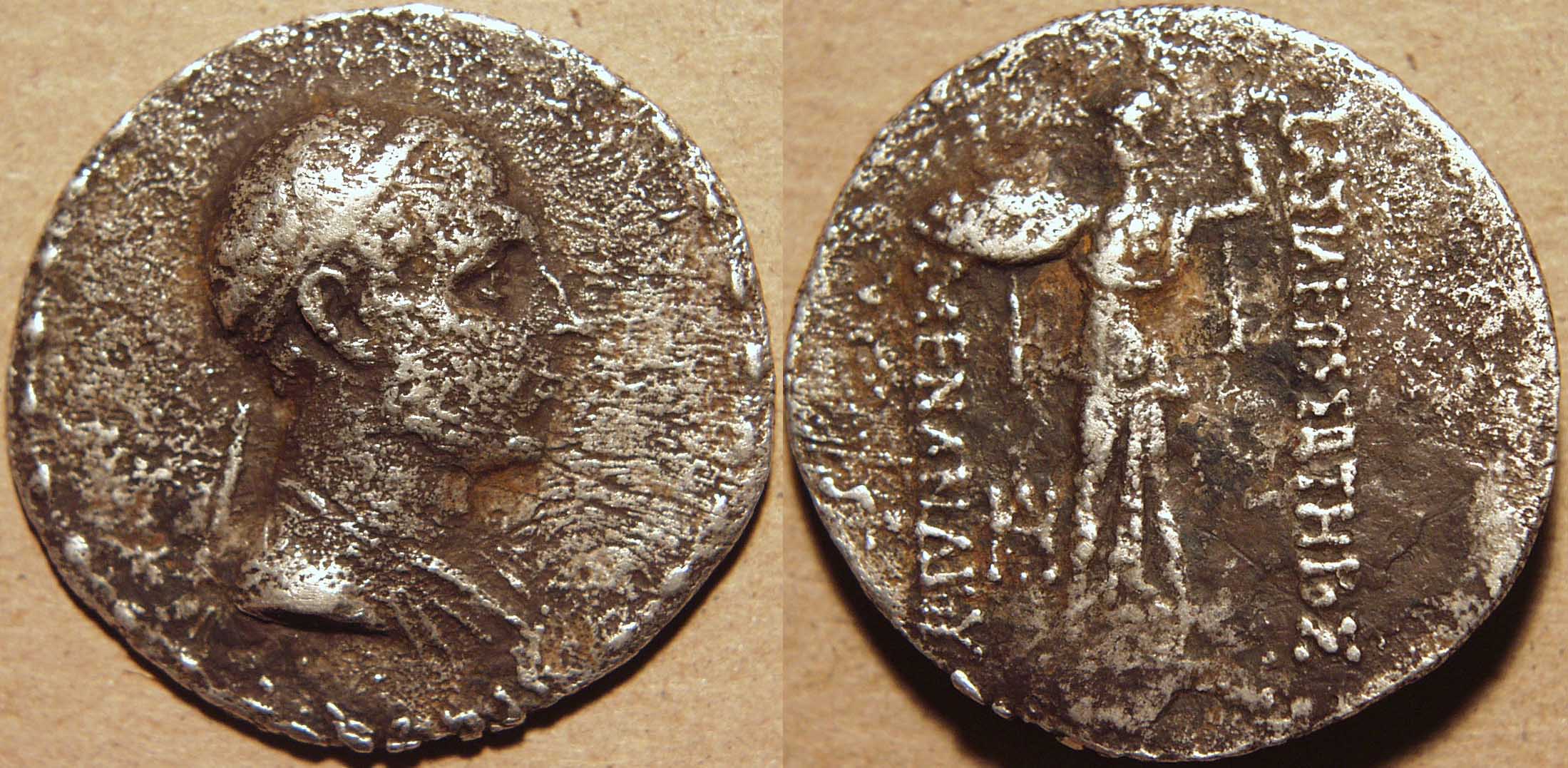
|
Menander I, Silver tetradrachm (Attic standard)
Weight: 13.28 gm. Diameter: 32 mm Die axis: 12 o'clock
Bare-headed, diademed bust of king right, bead and reel border around:
Seen from behind, Athena Alkidemos standing left, holding shield
on outstretched left arm, hurling thunderbolt with right hand,
monogram at left,
Greek legend at right and left: BAΣIΛEΩΣ ΣΩTHPOΣ / MENANΔPOY
(Basileos Soteros Menandrou ... of King Menander, the Savior)
Reference: MIG 212, Bop 11
|
 |
As mentioned in the introduction, the Attic weight coins of Menander are extremely rare, even in the poor
condition of this coin, suggesting that they were only ceremonial issues. Bopearachchi has speculated that they signify an expansion of Menander's kingdom to
Bactria after the death of Eucratides I in c.145 BCE, but their extreme rarity, and the fact that no lower denominations are known, suggests that they were never
regular issues. Other Indo-Greek kings who ruled only
south of the Hindu Kush also issued rare Attic weight tetradrachms. Nevertheless, it seems quite clear that these Attic weight coins were issued well into
Menander's reign, as the representation of Athena on these coins matches the one on the mature phase of Menander's "Indian" coinage.
|
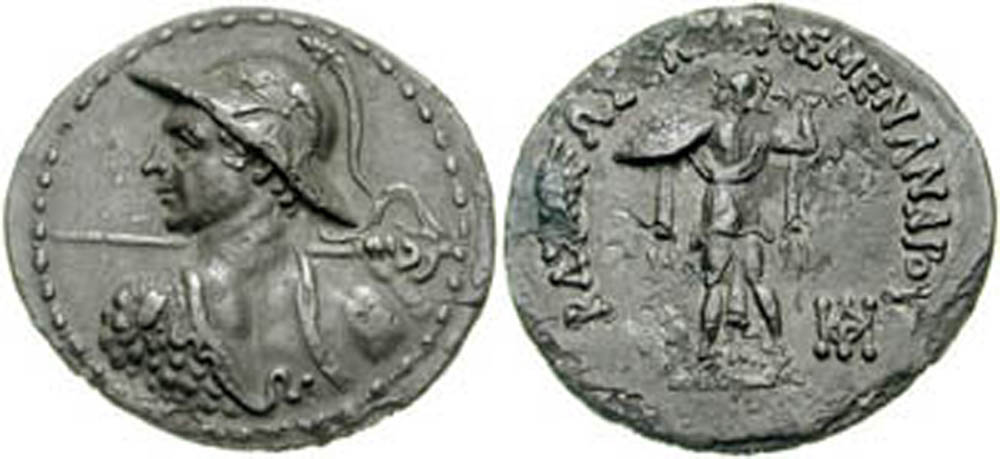
|
Menander I, Silver tetradrachm (Attic standard)
Weight: 13.03 gm. Diameter: na Die axis: na
Helmeted bust of king left, seen from behind, holding spear in right hand,
bead border around:
Seen from behind, Athena Alkidemos standing left, holding horizontal shield
on outstretched left arm, hurling thunderbolt with right hand,
monogram at right,
Greek legend above: BAΣIΛEΩΣ ΣΩTHPOΣ / MENANΔPOY
Reference: MIG ---, Bop ---, CNG Triton VI, lot 537
|
 |
A previously unknown type that appeared in a 2003 CNG auction. (photo, courtesy CNG)
|
 |
 |
 |
Indian Standard Silver Coins |
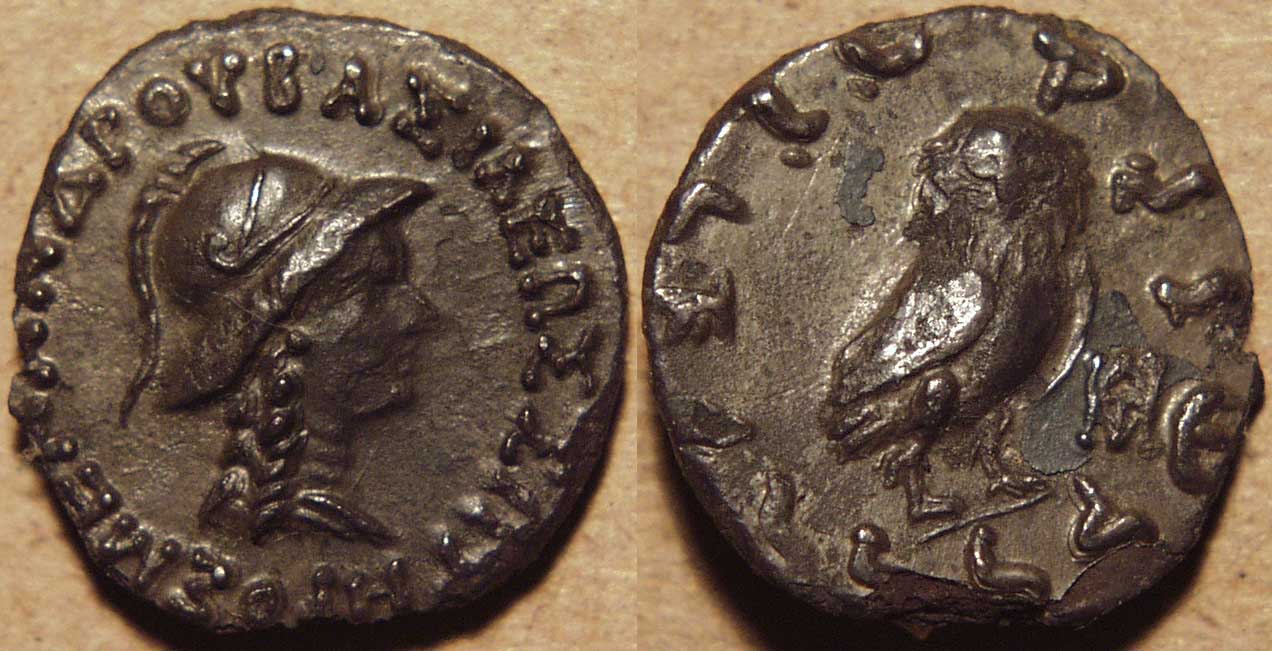
|
Menander I, Silver drachm (Indian standard)
Weight: 1.05 gm. Diameter: 15 mm Die axis: 12h
Helmeted bust of Athena right, continuous Greek legend around:
BAΣIΛEΩΣ ΣΩTHPOΣ MENANΔPOY
Owl standing three-quarters right, monogram at right,
Kharoshthi legend around: maharajasa tratarasa menamdrasa
Reference: MIG 213b, Bop 2C
|
 |
The vast bulk of Menander's coinage adheres to a so-called "Indian standard" of lighter weight coins. In this standard,
the drachm weighed about 2.45 gm (the very low weight of this drachm is the result of the coin having sat in water for a very long time ... a phenomenon often
seen on coins from the Mir Zakah hoard). The Indian standard coins are also bilingual, with a legend in Prakrit written on the back in Kharoshthi letters translating
the Greek legend on the front of the coin.
|

|
Menander I, Silver drachm (Indian standard)
Weight: 2.43 gm. Diameter: 18 mm Die axis: 1h
Diademed, bare-headed bust of king left, seen from behind, holding spear in right hand,
continuous Greek legend around: BAΣIΛEΩΣ ΣΩTHPOΣ MENANΔPOY
Seen from in front, Athena Alkidemos standing right,
holding aegis on outstretched left arm,
hurling thunderbolt with right hand, monogram at right,
Kharoshthi legend around: maharajasa tratarasa menamdrasa
Reference: MIG 220c, Bop 3B
|
 |
Bopearachchi places this coin type early in Menander's reign, as it still has the Greek and Kharoshthi legends presented
in a continuous fashion (as on the coins of Antimachus II), and bears only the monograms that it shares with the coins of Antimachus II.
|
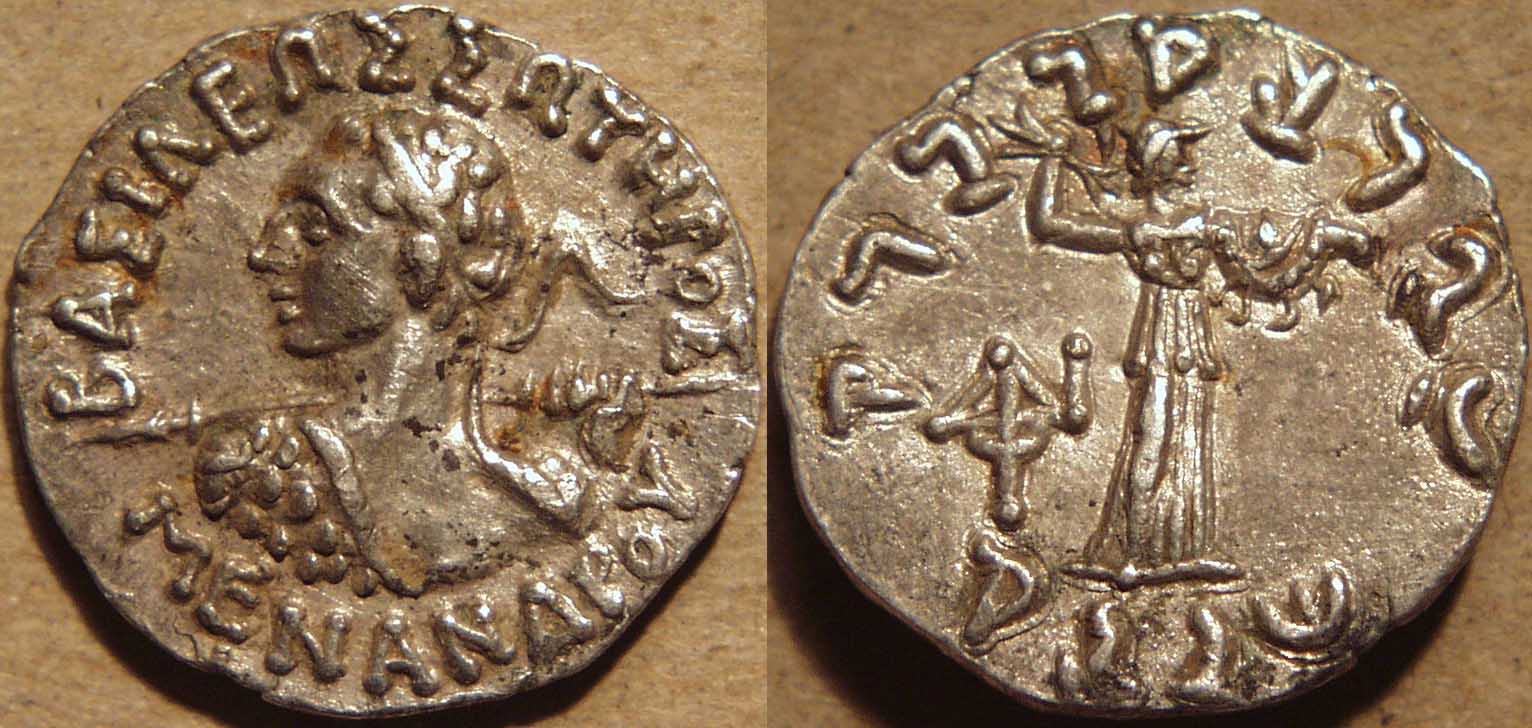
|
Menander I, Silver drachm (Indian standard)
Weight: 2.44 gm. Diameter: 18 mm Die axis: 1h
Diademed, bare-headed bust of king left, seen from behind, holding spear in right hand,
discontinuous Greek legend around: BAΣIΛEΩΣ ΣΩTHPOΣ / MENANΔPOY
Seen from in front, Athena Alkidemos standing right,
holding aegis on outstretched left arm,
hurling thunderbolt with right hand, monogram at right,
discontinuous Kharoshthi legend around: maharajasa tratarasa / menamdrasa
Reference: MIG 221b, Bop 6A
|
 |
At some point relatively early in Menander's reign, the disposition of the legends was changed to a discontinuous format
in which the first two words were placed in an arc at the top of the coin and the king's name was presented in an arc at the bottom. This coin was probably issued
early in that series, as it retains the front-facing representation of Athena on the reverse of the coin.
|
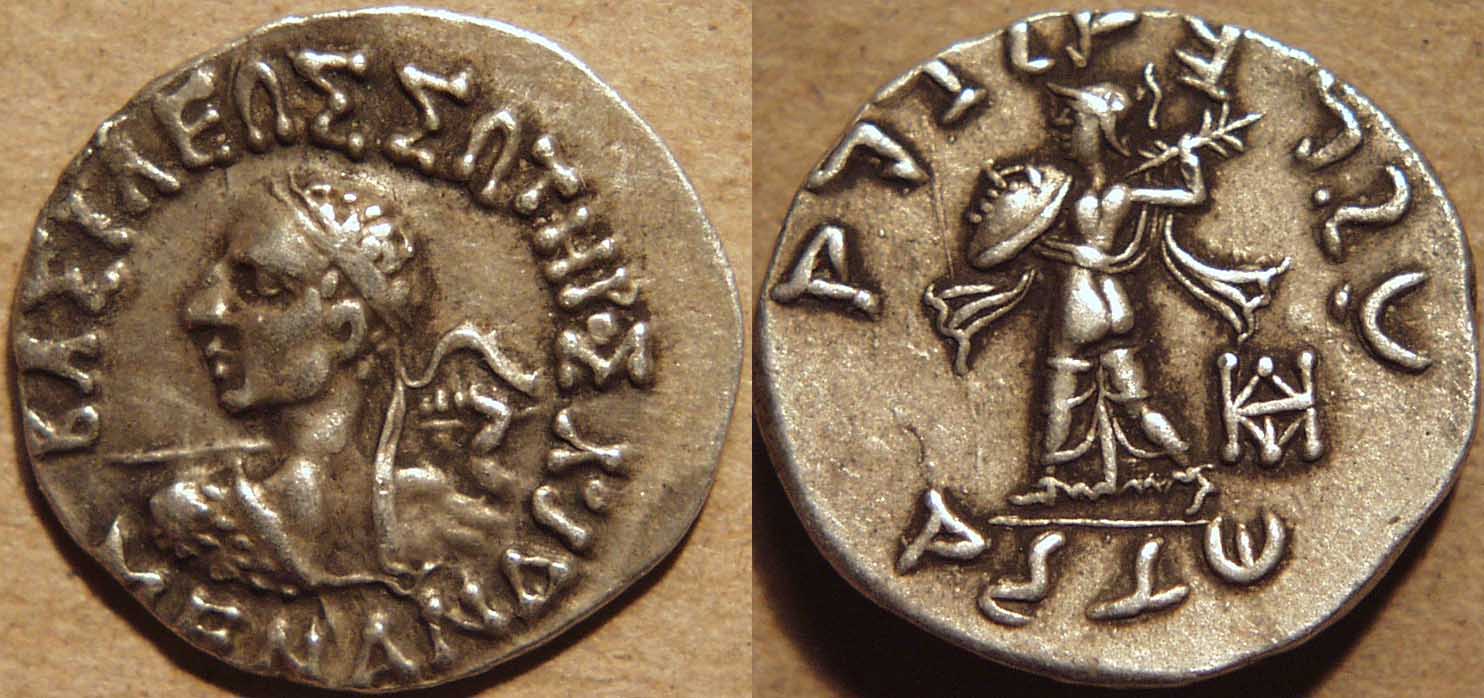
|
Menander I, Silver drachm (Indian standard)
Weight: 2.45 gm. Diameter: 18 mm Die axis: 1h
Diademed, bare-headed bust of king left, seen from behind, holding spear in right hand,
discontinuous Greek legend around: BAΣIΛEΩΣ ΣΩTHPOΣ / MENANΔPOY
Seen from behind, Athena Alkidemos standing left, holding sloping shield
on outstretched left arm, hurling thunderbolt with right hand,
monogram at right,
discontinuous Kharoshthi legend around: maharajasa tratarasa / menamdrasa
Reference: MIG 224b, Bop 7E
|
 |
The next phase of the coinage altered the representation of Athena to one where she is seen from behind, holding a sloping
shield instead of the aegis on her outstretched left arm.
|

|
Menander I, Silver tetradrachm (Indian standard)
Weight: 9.78 gm. Diameter: 24 mm Die axis: 12h
Diademed, bare-headed bust of king left, seen from behind, holding spear in right hand,
discontinuous Greek legend around: BAΣIΛEΩΣ ΣΩTHPOΣ / MENANΔPOY
Seen from behind, Athena Alkidemos standing left, holding horizontal shield
on outstretched left arm, hurling thunderbolt with right hand,
monogram at right,
discontinuous Kharoshthi legend around: maharajasa tratarasa / menamdrasa
Reference: MIG 219b, Bop 8A
|
 |
The final, and longest, phase of the coinage had the image of Athena seen from behind and holding a shield
horizontally on her outstretched left arm. It appears the first tetradrachms were issued in this format, as none are known for the other formats. It was in this phase
that various other obverse representations of the king were also introduced. The Attic weight coins, presented at the top of this table, must have been issued
during this phase, as the representation of Athena on those coins matches this one.
|

|
Menander I, Silver drachm (Indian standard)
Weight: 2.31 gm. Diameter: 19 mm Die axis: 1h
Diademed, bare-headed bust of king left, seen from behind, holding spear in right hand,
discontinuous Greek legend around: BAΣIΛEΩΣ ΣΩTHPOΣ / MENANΔPOY
Seen from behind, Athena Alkidemos standing left, holding horizontal shield
on outstretched left arm, hurling thunderbolt with right hand,
monogram at right,
discontinuous Kharoshthi legend around: maharajasa tratarasa / menamdrasa
Reference: MIG 225f, Bop 9C
|
 |
In the final phase of the coinage, each silver type typically featured a tetradrachm and a drachm denomination.
|

|
Menander I, Silver drachm (Indian standard)
Weight: 2.37 gm. Diameter: 18 mm Die axis: 12h
Diademed, helmeted bust of king left, seen from behind, holding spear in right hand,
discontinuous Greek legend around: BAΣIΛEΩΣ ΣΩTHPOΣ / MENANΔPOY
Seen from behind, Athena Alkidemos standing left, holding horizontal shield
on outstretched left arm, hurling thunderbolt with right hand,
monogram at right,
discontinuous Kharoshthi legend around: maharajasa tratarasa / menamdrasa
Reference: MIG 226a, Bop 10B
|
 |
In this variant of the "spearthruster" type, the king is shown wearing a helmet. No tetradrachm is known for this type.
|

|
Menander I, Silver tetradrachm (Indian standard)
Weight: 9.79 gm. Diameter: 25 mm Die axis: 12h
Diademed, bare-headed bust of king right, discontinuous Greek legend around:
BAΣIΛEΩΣ ΣΩTHPOΣ / MENANΔPOY
Seen from behind, Athena Alkidemos standing left, holding horizontal shield
on outstretched left arm, hurling thunderbolt with right hand,
monograms at left and right,
discontinuous Kharoshthi legend around: maharajasa tratarasa / menamdrasa
Reference: MIG 214c, Bop 12A
|
 |
One variant representation of the king shows his bust facing right, wearing a diadem but no head-dress.
|

|
Menander I, Silver tetradrachm (Indian standard)
Weight: 9.84 gm. Diameter: 28 mm Die axis: 12h
Diademed, bare-headed bust of king right, discontinuous Greek legend around:
BAΣIΛEΩΣ ΣΩTHPOΣ / MENANΔPOY
Seen from behind, Athena Alkidemos standing left, holding horizontal shield
on outstretched left arm, hurling thunderbolt with right hand,
monograms at left and right,
discontinuous Kharoshthi legend around: maharajasa tratarasa / menamdrasa
Reference: MIG 214c, Bop 12A
|

|
Menander I, Silver drachm (Indian standard)
Weight: 2.47 gm. Diameter: 17 mm Die axis: 12h
Diademed, bare-headed bust of king right, discontinuous Greek legend around:
BAΣIΛEΩΣ ΣΩTHPOΣ / MENANΔPOY
Seen from behind, Athena Alkidemos standing left, holding horizontal shield
on outstretched left arm, hurling thunderbolt with right hand,
monogram at right,
discontinuous Kharoshthi legend around: maharajasa tratarasa / menamdrasa
Reference: MIG 215f, Bop 13O
|
 |
Note the tight die axes that Menender's celators were able to maintain ... almost all coins have a die axis of 12 o'clock,
as do modern machine-made Indian coins.
|

|
Menander I, Silver tetradrachm (Indian standard)
Weight: 9.74 gm. Diameter: 26 mm Die axis: 12:30h
Diademed, helmeted bust of king right, discontinuous Greek legend around:
BAΣIΛEΩΣ ΣΩTHPOΣ / MENANΔPOY
Seen from behind, Athena Alkidemos standing left, holding horizontal shield
on outstretched left arm, hurling thunderbolt with right hand,
monograms at left and right,
discontinuous Kharoshthi legend around: maharajasa tratarasa / menamdrasa
Reference: MIG 217f, Bop 15B
|
 |
A final variant representation of the king shows his bust facing right, wearing a diadem and a helmet.
|
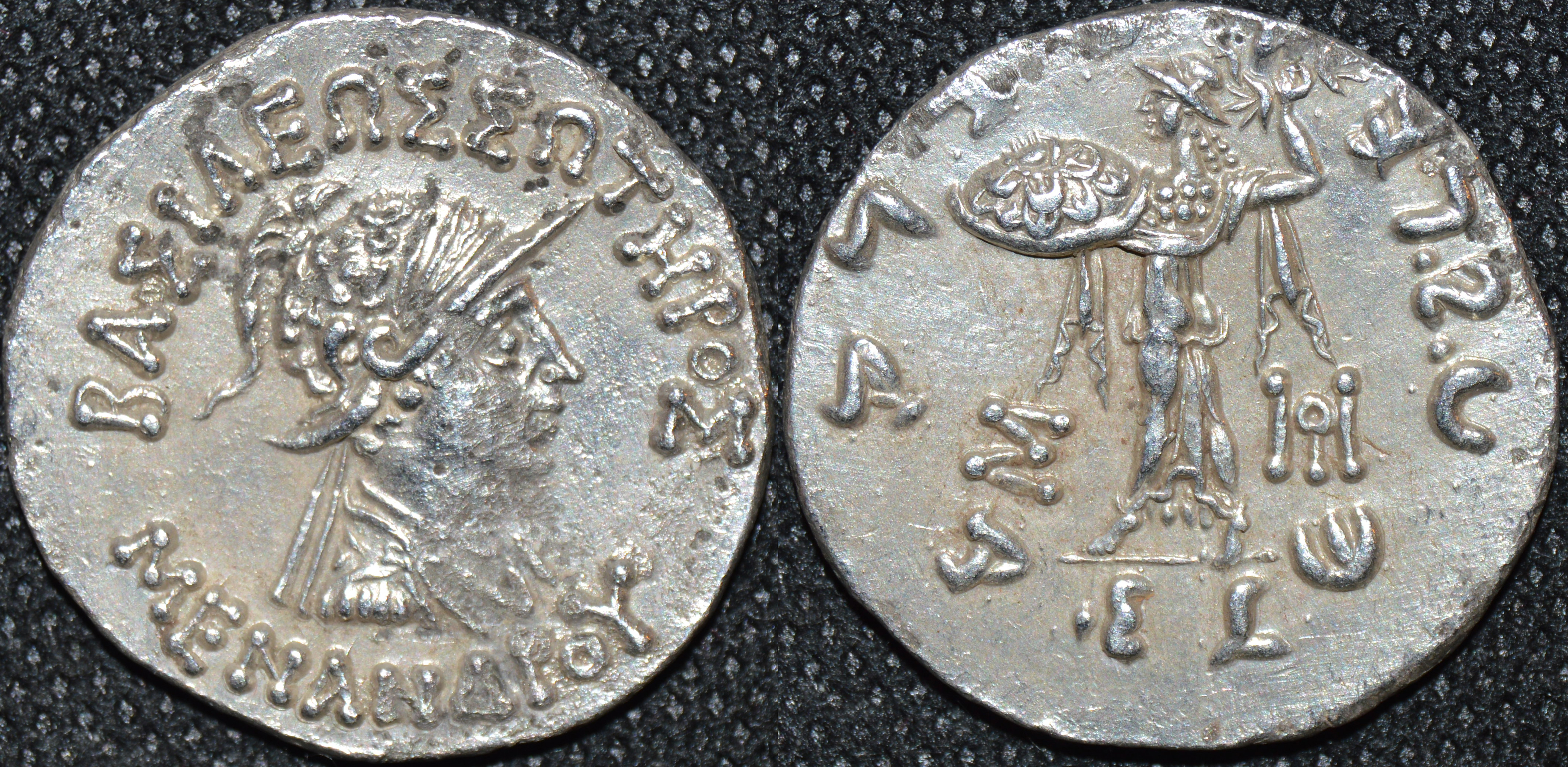
|
Menander I, Silver tetradrachm (Indian standard)
Weight: 9.60 gm. Diameter: 26 mm Die axis: 11h
Diademed, helmeted bust of king right, discontinuous Greek legend around:
BAΣIΛEΩΣ ΣΩTHPOΣ / MENANΔPOY
Seen from behind, Athena Alkidemos standing left, holding horizontal shield
on outstretched left arm, hurling thunderbolt with right hand,
monograms at left and right,
discontinuous Kharoshthi legend around: maharajasa tratarasa / menamdrasa
Reference: MIG 217f, Bop 15B
|

|
This coin has some corrosion, but an astonishing reverse with a beautiful portrait of Athena. The detail on
the shield is amazing.
|
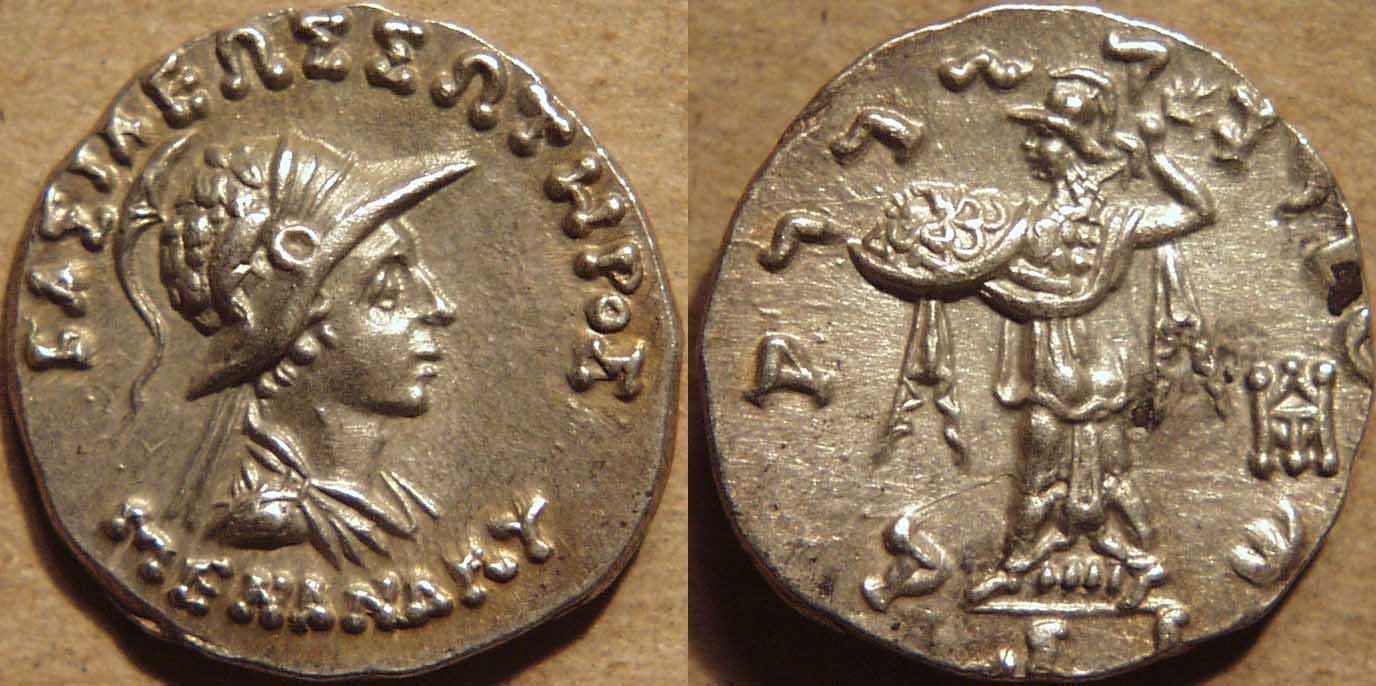
|
Menander I, Silver tetradrachm (Indian standard)
Weight: 2.46 gm. Diameter: 16 mm Die axis: 12h
Diademed, helmeted bust of king right, discontinuous Greek legend around:
BAΣIΛEΩΣ ΣΩTHPOΣ / MENANΔPOY
Seen from behind, Athena Alkidemos standing left, holding horizontal shield
on outstretched left arm, hurling thunderbolt with right hand,
monograms at left and right,
discontinuous Kharoshthi legend around: maharajasa tratarasa / menamdrasa
Reference: MIG 218c, Bop 16I
|
 |
Bronze Coins (Indian Standard) |

|
Menander I, Bronze Quadruple
Weight: 9.40 gm. Dimensions: 24 x 22 mm Die axis: 12h
Helmeted bust of Athena right, Greek legend on three sides:
BAΣIΛEΩΣ / ΣΩTHPOΣ / MENANΔPOY
Round shield with Gorgon head in center, monogram at left,
Kharoshthi legend above and below: maharajasa tratarasa / menamdrasa
Reference: MIG 246d(3), Bop 17A
|
 |
All of Menander's wide array of bronze types is in the rectangular format apparently favored south of the
Hindu Kush mountains. There seems to have been a period of experimentation initially as to the disposition of the legends. On this coin, the Greek
legend on the obverse starts at the top, then goes to the left, and then to the bottom. The Kharoshthi legend is in two lines, top and bottom.
|

|
Menander I, Bronze Quadruple
Weight: 9.86 gm. Dimensions: 24 x 22 mm Die axis: 12h
Helmeted bust of Athena right, Greek legend on three sides:
BAΣIΛEΩΣ ΣΩTHPOΣ MENANΔPOY
Round shield with Gorgon head in center, monogram at left,
Kharoshthi legend above and below: maharajasa tratarasa / menamdrasa
Reference: MIG 246c, Bop 18A
|
 |
On this coin, the Greek legend on the obverse starts at the left, continues to the top and then to
the right. The Kharoshthi legend is in two lines, top and bottom, as on the previous coin.
|
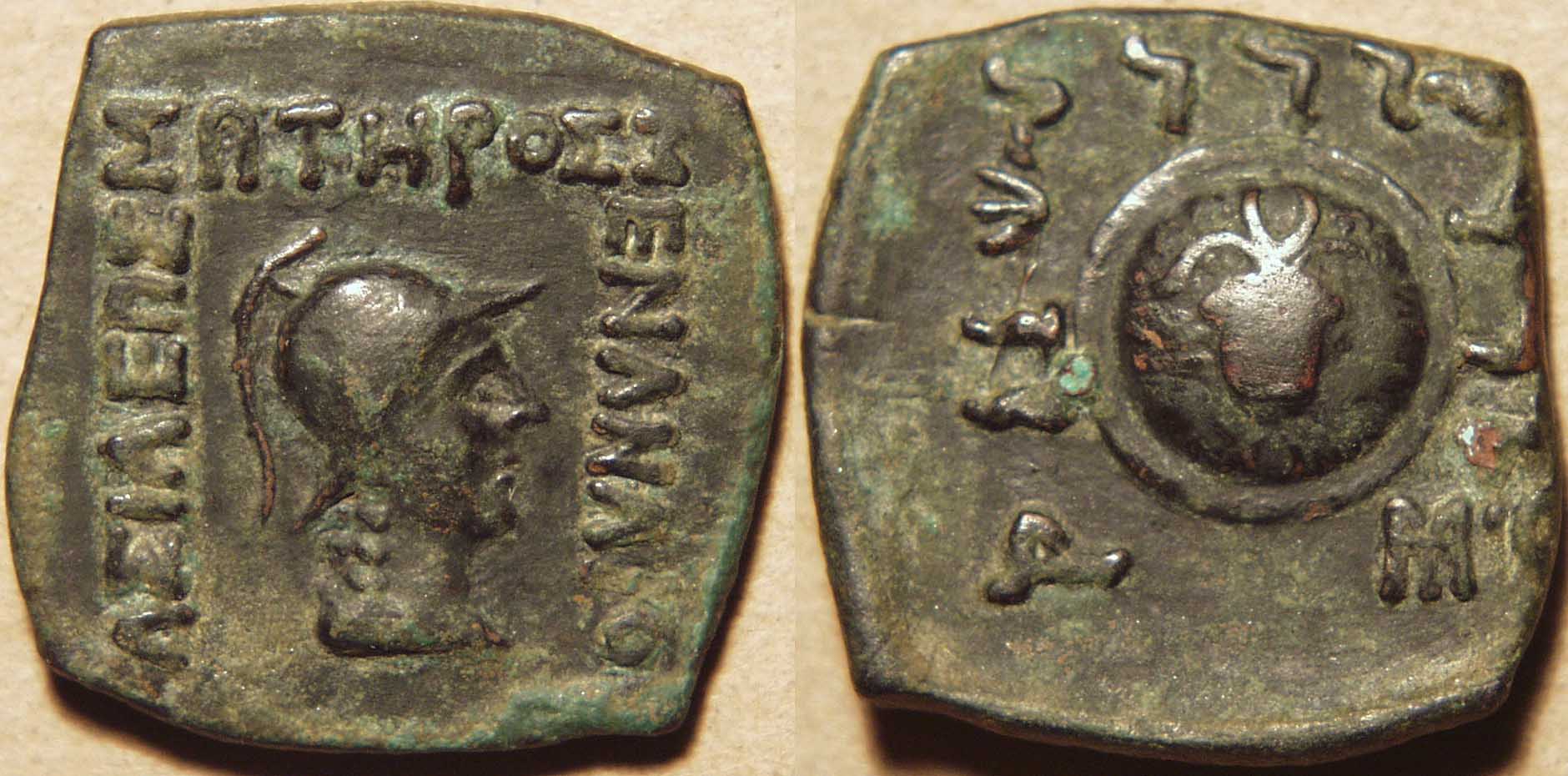
|
Menander I, Bronze Quadruple
Weight: 5.92 gm. Dimensions: 22 x 22 mm Die axis: 12h
Helmeted bust of Athena right, Greek legend on three sides:
BAΣIΛEΩΣ ΣΩTHPOΣ MENANΔPOY
Round shield with Gorgon head in center, monogram at right,
Kharoshthi legend on three sides: maharajasa tratarasa menamdrasa
Reference: MIG 246d(1), Bop 19A
|
 |
On this coin, the Greek legend remains as on the previous coin, and the Kharoshthi legend also
becomes continuous and placed on three sides, starting at the right.
|
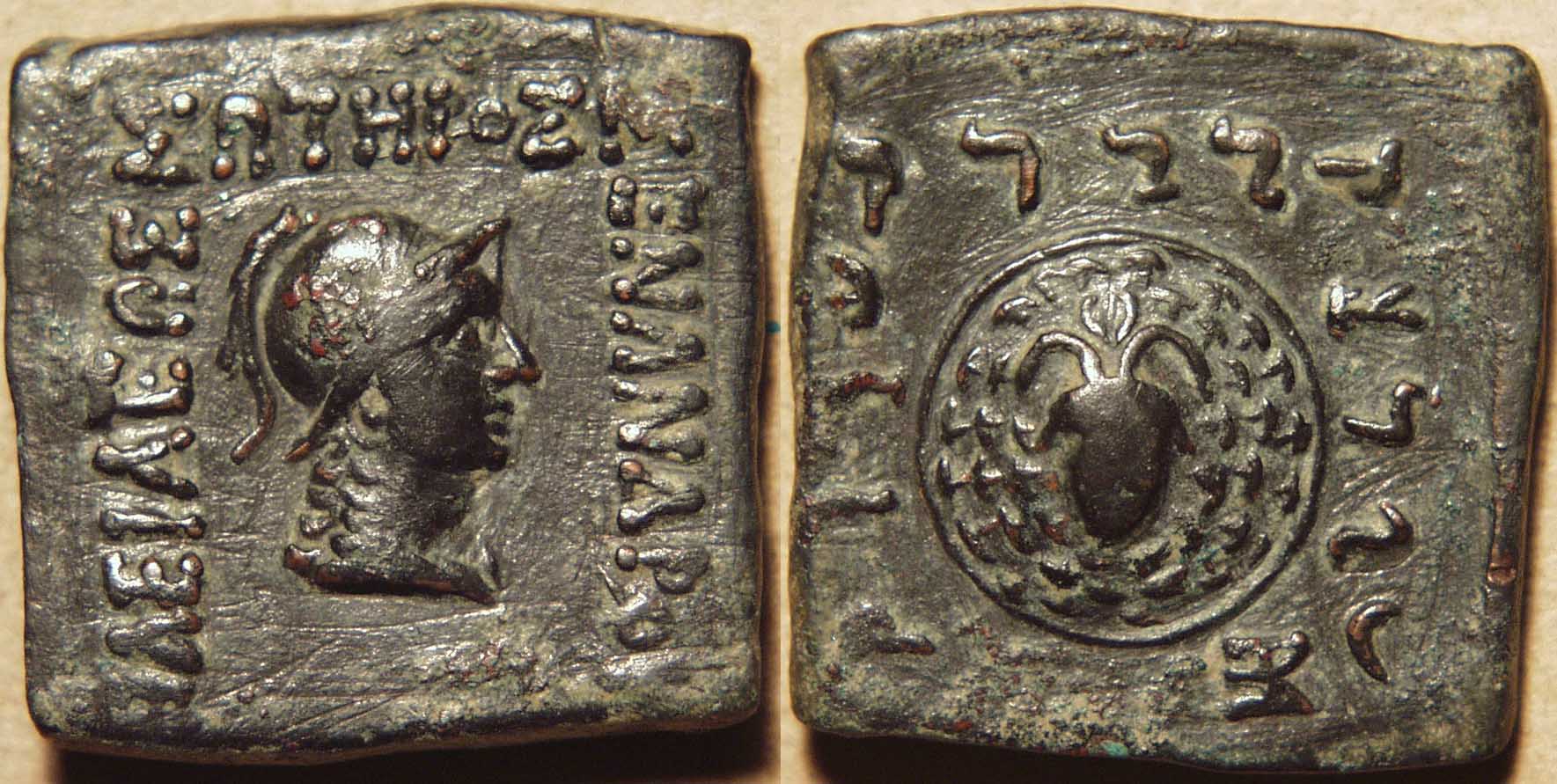
|
Menander I, Bronze Quadruple
Weight: 6.91 gm. Dimensions: 21 x 21 mm Die axis: 12h
Helmeted bust of Athena right, Greek legend on three sides:
BAΣIΛEΩΣ ΣΩTHPOΣ MENANΔPOY
Round shield with Gorgon head in center, monogram at right,
Kharoshthi legend on three sides: maharajasa tratarasa menamdrasa
Reference: MIG 246d(1), Bop 19A
|
 |
A variety of the previous coin, not noted as yet, in which the monogram has been placed on its side
(i.e. rotated 90 degrees). Another oddity is that the M of MENANΔPOY has been oriented with the word ΣΩTHPOΣ
rather than with the rest of the king's name.
|
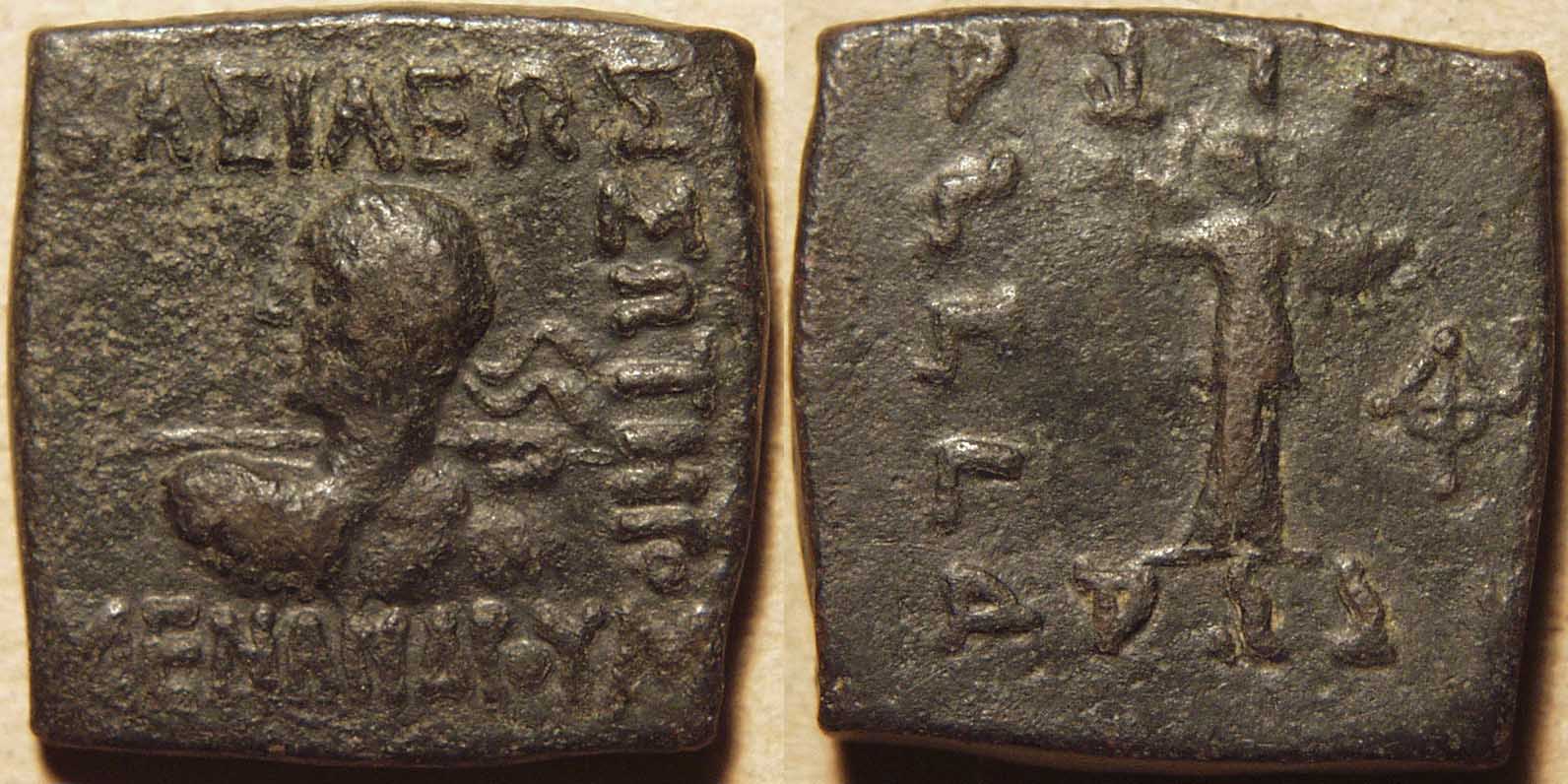
|
Menander I, Bronze Quadruple
Weight: 9.57 gm. Dimensions: 21 x 21 mm Die axis: 12h
Diademed, bare-headed bust of king left, seen from behind, holding spear in right hand,
Greek legend on three sides: BAΣIΛEΩΣ ΣΩTHPOΣ / MENANΔPOY
Seen from in front, Athena Alkidemos standing right,
holding aegis on outstretched left arm,
hurling thunderbolt with right hand, monogram at right,
Kharoshthi legend on three sides: maharajasa tratarasa / menamdrasa
Reference: MIG 237b, Bop 21A
|
 |
Although Bopearachchi presents this coin after the Gorgon shield types above, it seems plausible to me
that this may have been the first bronze type, as its design (with spearthruster king and front-facing Athena Alkidemos) matches the first silver issues. The
legends are interrupted in that the first two words are presented continuously, but the king's name breaks the continuity so that it can be presented horizontally.
|
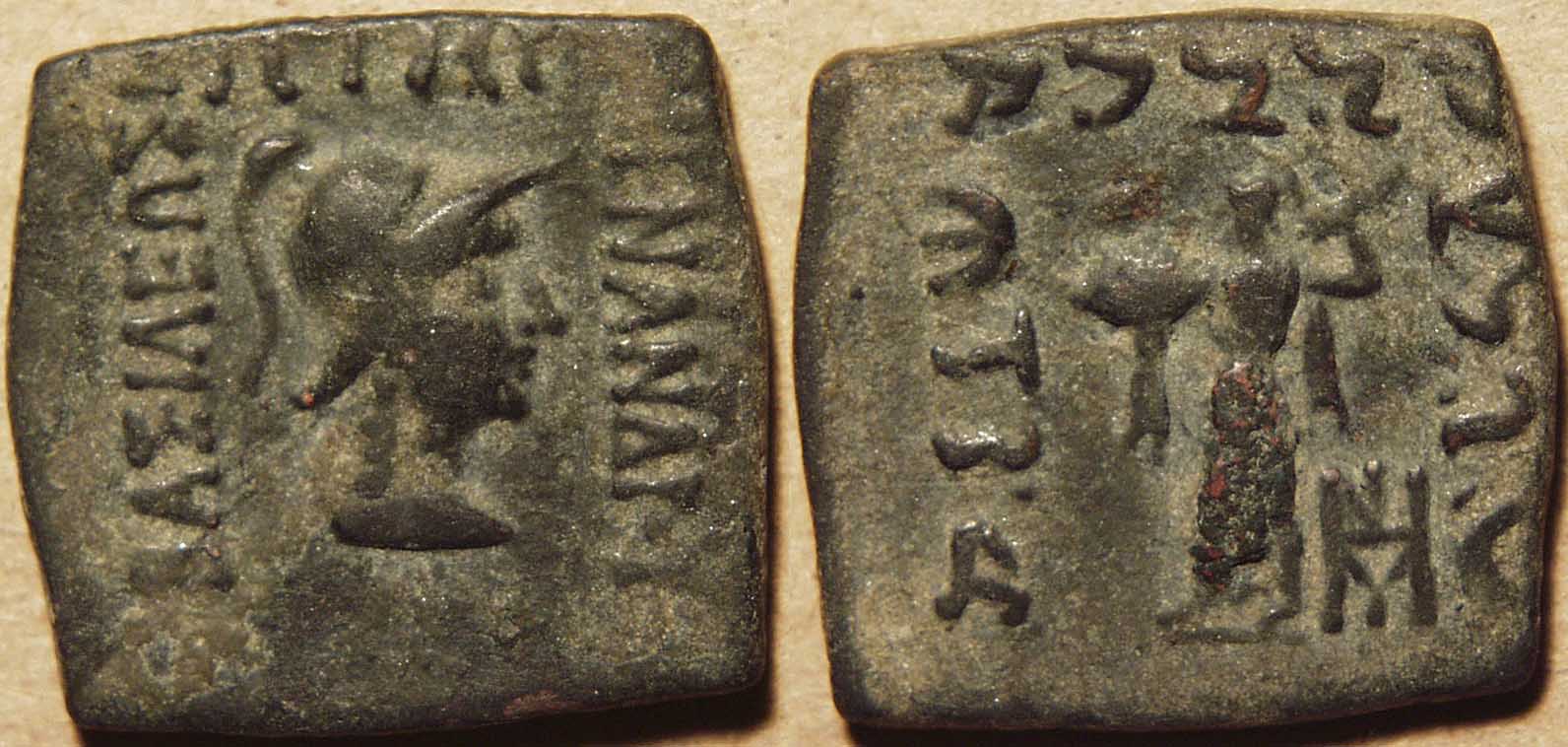
|
Menander I, Bronze Double
Weight: 5.76 gm. Dimensions: 21 x 20 mm Die axis: 12h
Helmeted bust of Athena right,
Greek legend on three sides: BAΣIΛEΩΣ ΣΩTHPOΣ MENANΔPOY
Seen from behind, Athena Alkidemos standing left, holding horizontal shield
on outstretched left arm, hurling thunderbolt with right hand,
monogram at right,
Kharoshthi legend on three sides: maharajasa tratarasa menamdrasa
Reference: MIG 239b, Bop 23C
|
 |
This coin arranges the three-sided legend a little more pleasingly, as the legends are continuous without
any word needing to be upside down.
|

|
Menander I, Bronze 16-tuple
Weight: 40.63 gm. Dimensions: 29 x 25 mm Die axis: 12h
Helmeted bust of Athena right,
Greek legend on three sides: BAΣIΛEΩΣ ΣΩTHPOΣ MENANΔPOY
Horse prancing right, monogram at right,
Kharoshthi legend on three sides: maharajasa tratarasa menamdrasa
Reference: MIG 231a, Bop 24A
|
 |
An amazing coin at 40.63 gm ... the largest coin issued by Menander.
|
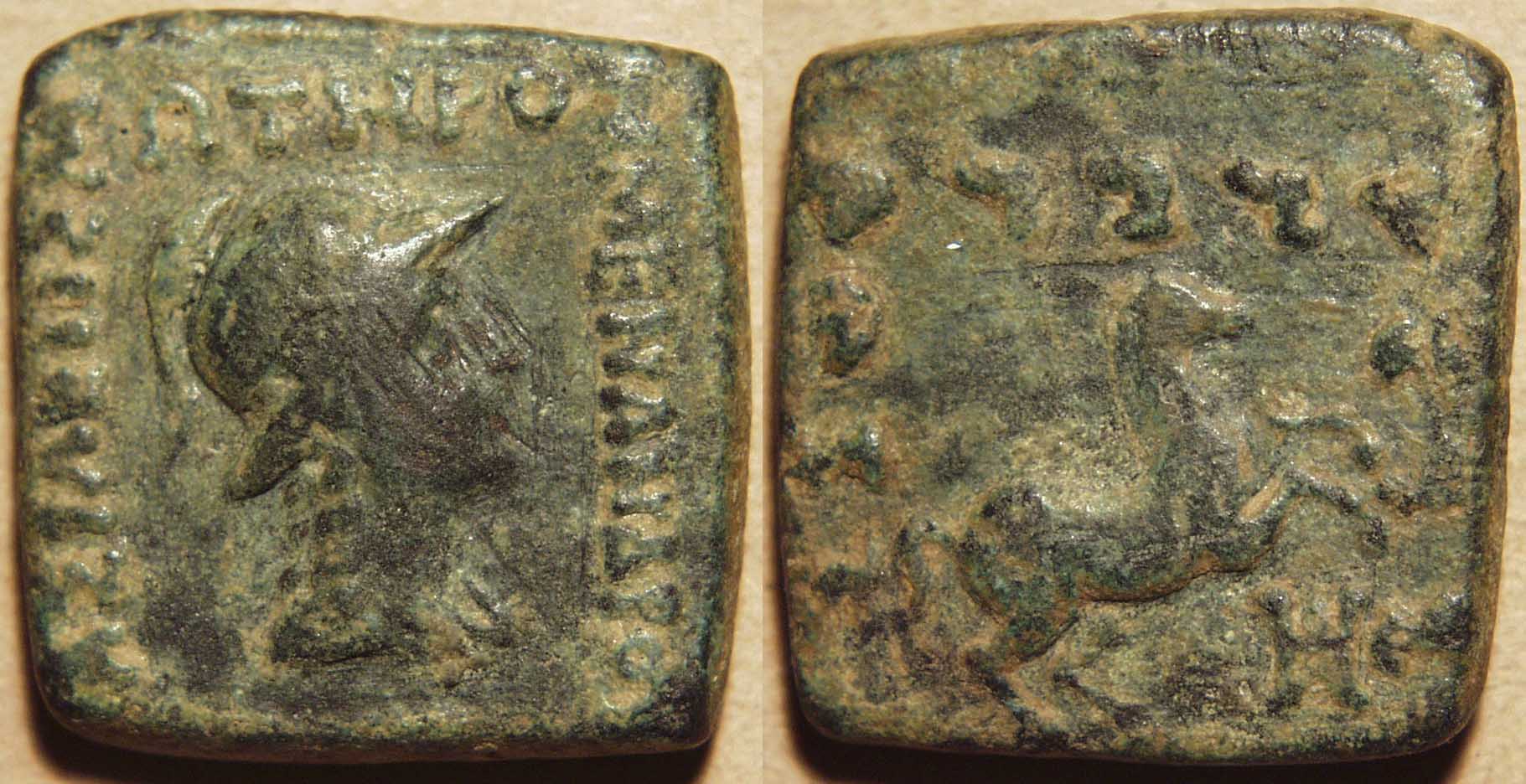
|
Menander I, Bronze octuple
Weight: 15.17 gm. Dimensions: 23 x 24 mm Die axis: 12h
Helmeted bust of Athena right,
Greek legend on three sides: BAΣIΛEΩΣ ΣΩTHPOΣ MENANΔPOY
Horse prancing right, monogram at right,
Kharoshthi legend on three sides: maharajasa tratarasa menamdrasa
Reference: MIG ---, Bop 39A
|
 |
Bopearachchi lists this as the last of Menander's coins, but it seems to follow from the previous coin, of which it seems
to be the half denomination. No smaller denominations, such as quadruples or doubles, are known, so perhaps these coins were the higher denominations for
other series.
|
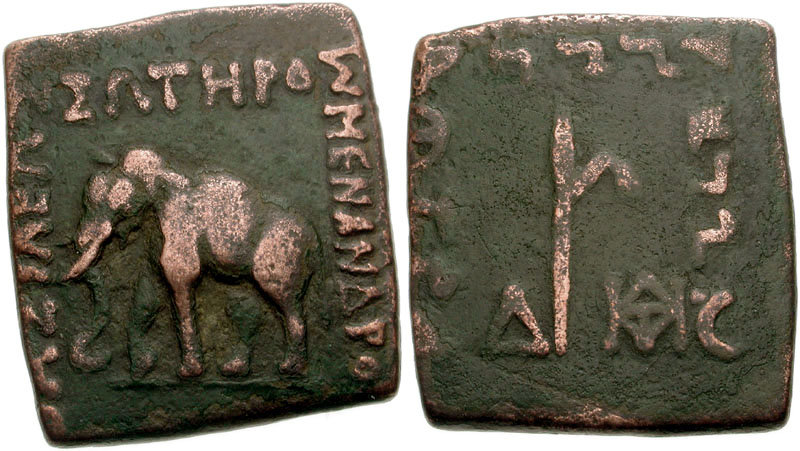
|
Menander I, Bronze Quadruple
Weight: 11.41 gm. Dimensions: 24 x 24 mm Die axis: 12h
Elephant walking left,
Greek legend on three sides: BAΣIΛEΩΣ ΣΩTHPOΣ MENANΔPOY
Elephant goad,
Δ at left, monogram at right,
Kharoshthi legend on three sides: maharajasa tratarasa menamdrasa
Reference: MIG 236, Bop 26A
|
 |
This, and the next few coins, are most interesting because they carry some extra letters: Δ (Greek delta)
on this one and B (Greek beta) and A (Greek alpha) on subsequent ones. Bopearachchi argues that these letters represent the denominations:
A for a single unit, B for a double unit and Δ for a quadruple unit. The weights of the coins match this theory, and A, B and Δ are the first, second
and fourth letters in the Greek alphabet. If the theory is true, it is a rare (the only?) instance of coins carrying stated denominations among all ancient Indian
coins. (photo
courtesy CNG)
|

|
Menander I, Bronze Quadruple
Weight: 8.21 gm. Dimensions: 17 x 17 mm Die axis: 12h
Elephant walking right,
Greek legend on three sides: BAΣIΛEΩΣ ΣΩTHPOΣ MENANΔPOY
Elephant goad,
Δ at left ?, monogram at right,
Kharoshthi legend on three sides: maharajasa tratarasa menamdrasa
Reference: MIG ---, Bop 38A
|
 |
A rare variation on the previous coin with the elephant walking to the right. Although no Δ is visible on this coin,
it is possible there was one there that got rubbed out with over-zealous cleaning. Bopearachchi lists this coin later in his catalogue, but it seems to belong with
the previous coin, with which it shares not only the themes but the monogram.
|

|
Menander I, Bronze Double
Weight: 5.55 gm. Dimensions: 20 x 20 mm Die axis: 12h
Helmeted bust of Athena right,
Greek legend on three sides: BAΣIΛEΩΣ ΣΩTHPOΣ MENANΔPOY
Seen from behind, Nike standing left, holding wreath and palm
B at right, monogram at left,
Kharoshthi legend on three sides: maharajasa tratarasa menamdrasa
Reference: MIG 238b, Bop 27B
|
 |
This very rare coin carries a B, possibly indicating its denomination as a double unit.
|
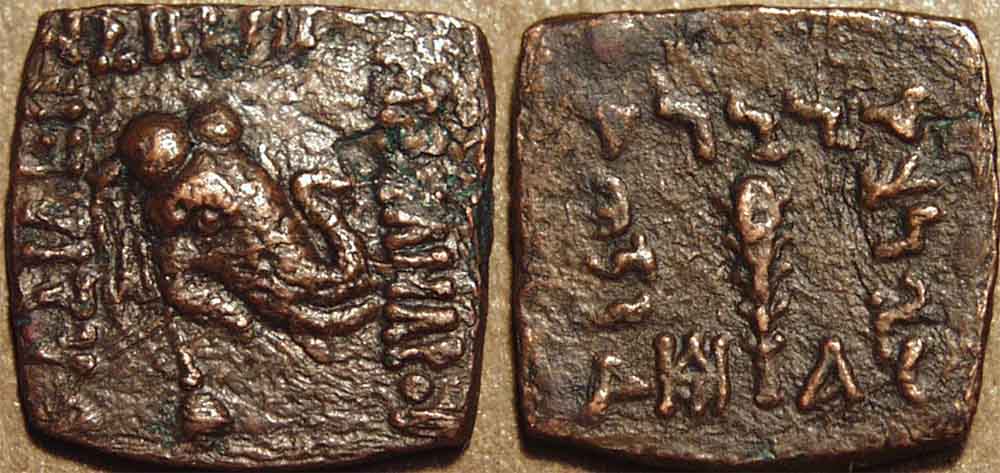
|
Menander I, Bronze Single unit
Weight: 1.97 gm. Dimensions: 14 x 14 mm Die axis: 12h
Elephant head three-quarters right,
Greek legend on three sides: BAΣIΛEΩΣ ΣΩTHPOΣ MENANΔPOY
Club, monogram at left, A at right,
Kharoshthi legend on three sides: maharajasa tratarasa menamdrasa
Reference: MIG 240a, Bop 28E
|
 |
The single unit carries the letter A, in several different locations.
|
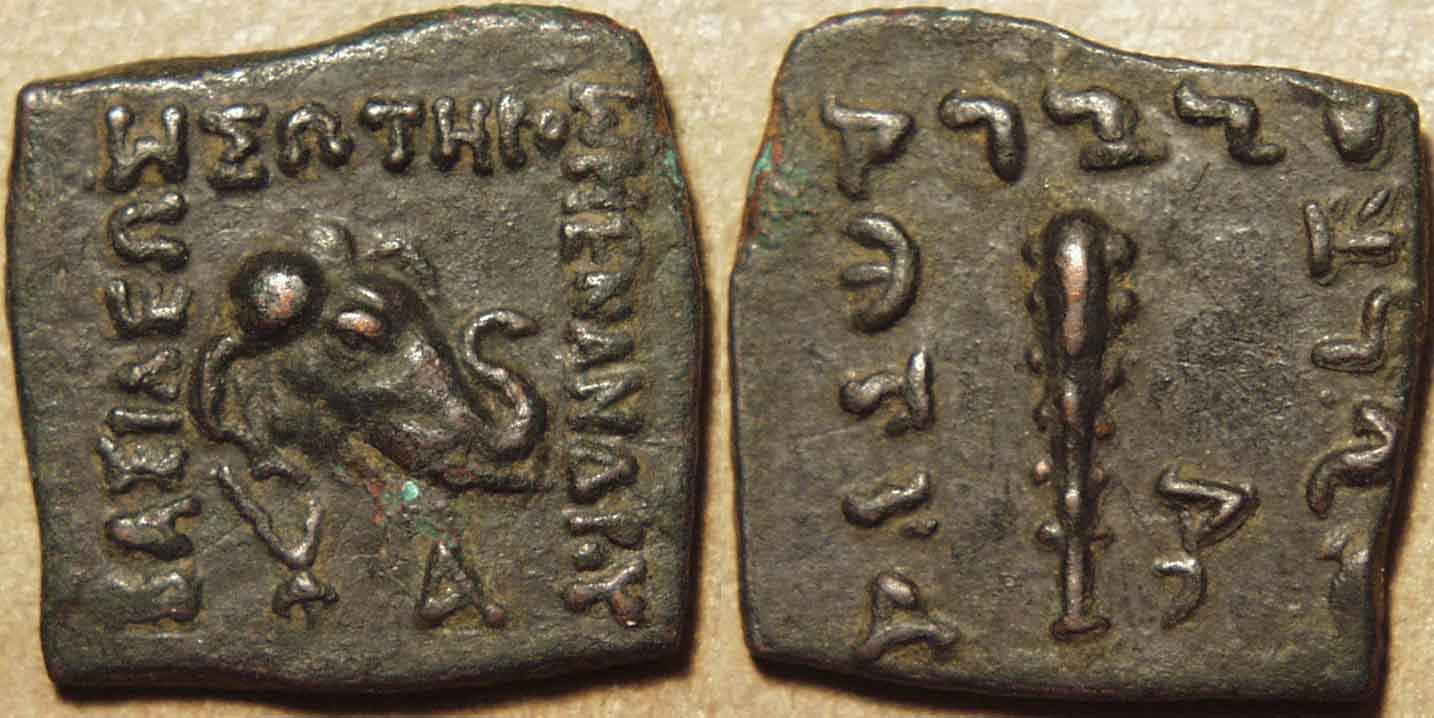
|
Menander I, Bronze Single unit
Weight: 2.57 gm. Dimensions: 15 x 15 mm Die axis: 12h
Elephant head three-quarters right, A below
Greek legend on three sides: BAΣIΛEΩΣ ΣΩTHPOΣ MENANΔPOY
Club, monogram at right,
Kharoshthi legend on three sides: maharajasa tratarasa menamdrasa
Reference: MIG --- (240d for type), Bop --- (28J for type), Bop & Rahman 397
|
 |
A rare variety with the A on the obverse, unlisted in the usual catalogues.
|
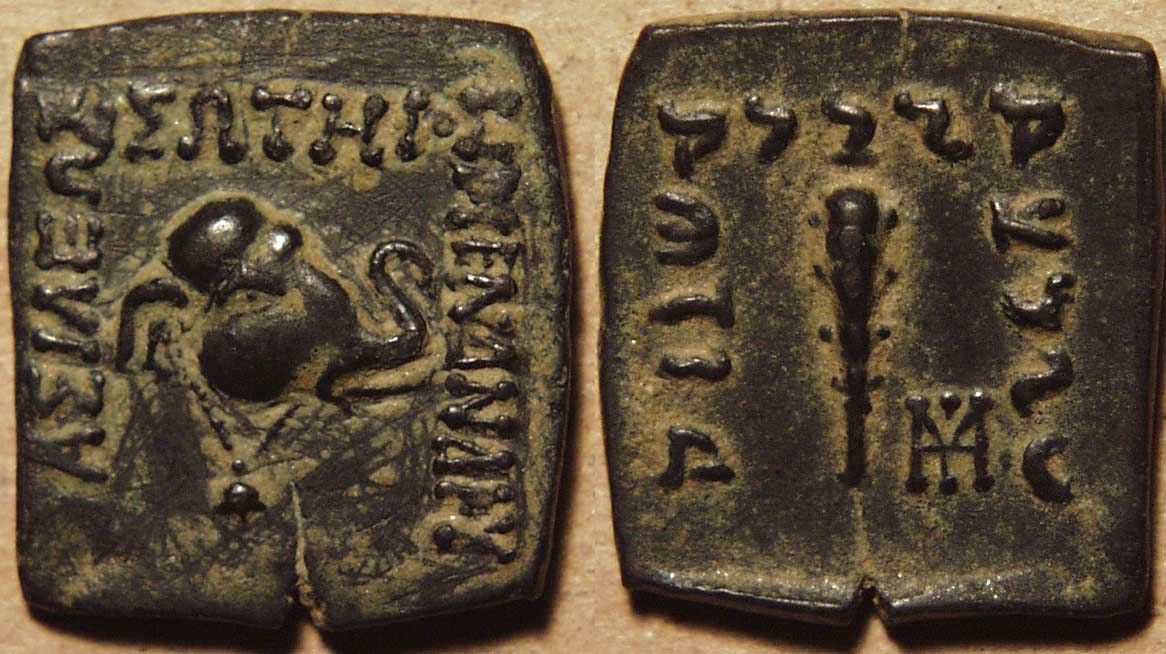
|
Menander I, Bronze Single unit
Weight: 2.72 gm. Dimensions: 15 x 16 mm Die axis: 12h
Elephant head three-quarters right,
Greek legend on three sides: BAΣIΛEΩΣ ΣΩTHPOΣ MENANΔPOY
Club, monogram at right,
Kharoshthi legend on three sides: maharajasa tratarasa menamdrasa
Reference: MIG 240h, Bop 28D
|
 |
This variety omits the A.
|
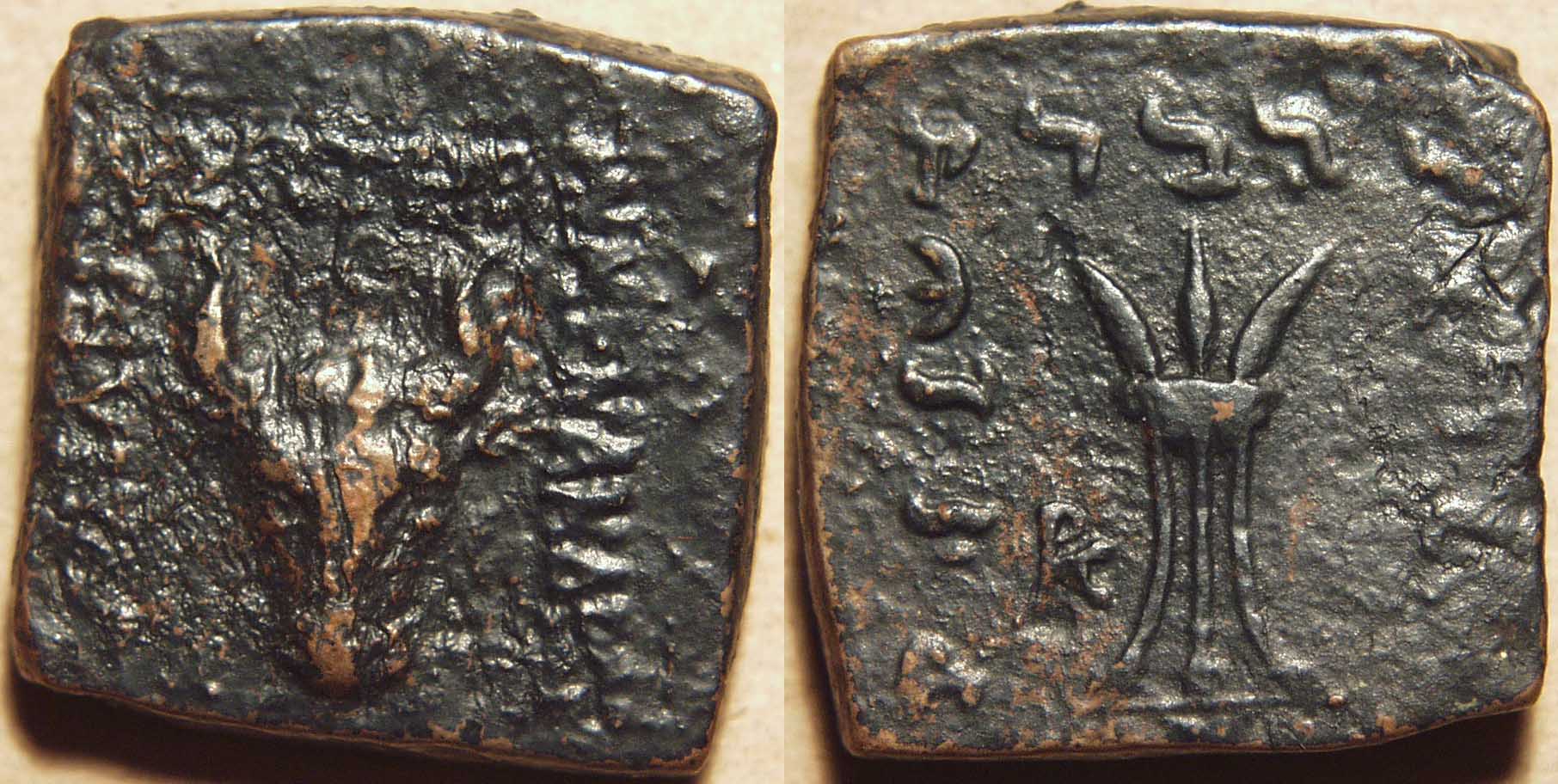
|
Menander I, Bronze Octuple
Weight: 19.98 gm. Dimensions: 23 x 24 mm Die axis: 12h
Head of bull facing,
Greek legend on three sides: BAΣIΛEΩΣ ΣΩTHPOΣ MENANΔPOY
Tripod, monogram at left,
Kharoshthi legend on three sides: maharajasa tratarasa menamdrasa
Reference: MIG 233a, Bop 29A
|
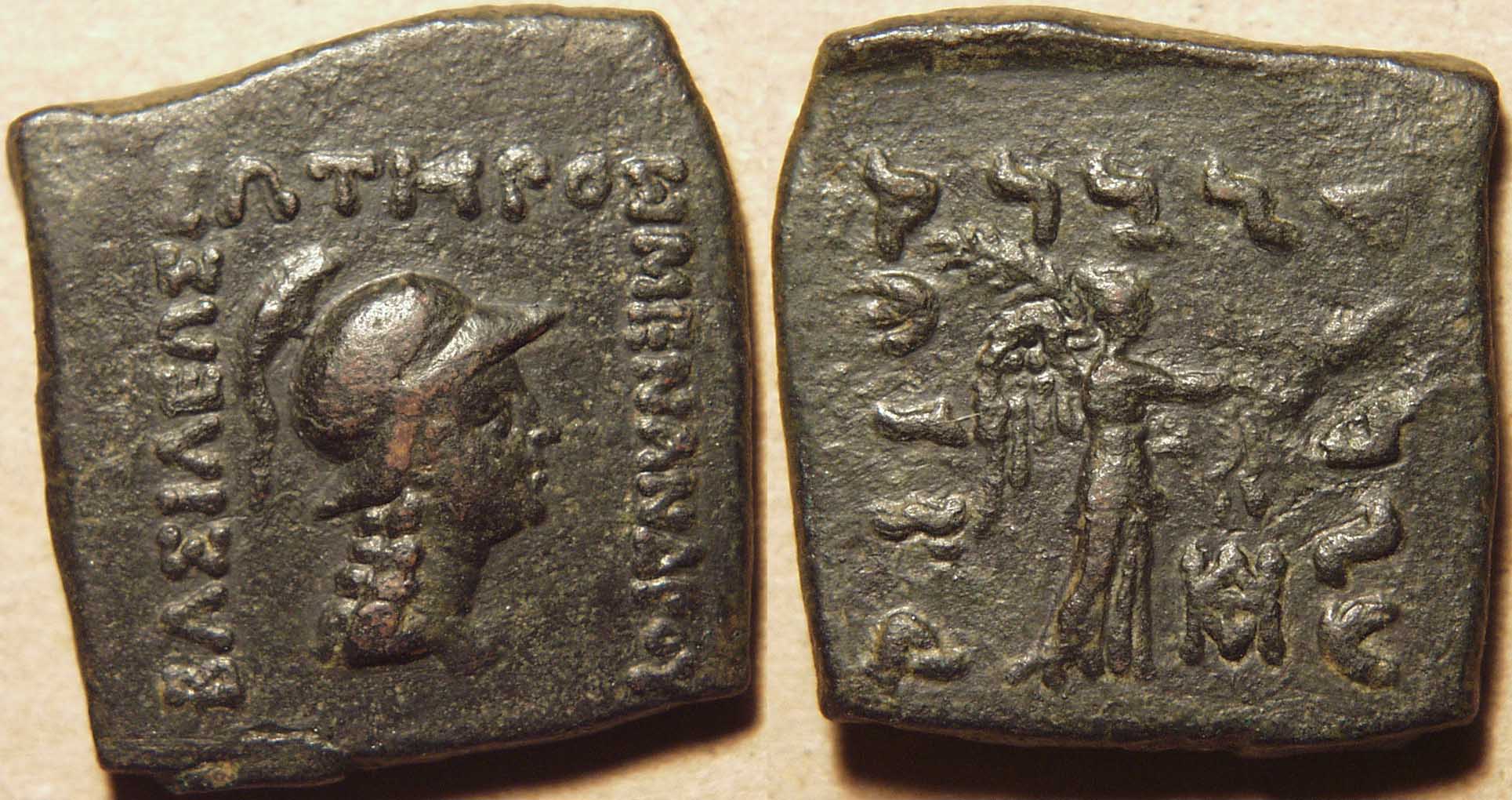
|
Menander I, Bronze Octuple
Weight: 14.71 gm. Dimensions: 26 x 25 mm Die axis: 12h
Helmeted bust of Athena right,
Greek legend on three sides: BAΣIΛEΩΣ ΣΩTHPOΣ MENANΔPOY
Winged Nike standing right, holding wreath and palm,
Kharoshthi legend on three sides: maharajasa tratarasa / menamdrasa
Reference: MIG 242a, Bop 31B
|
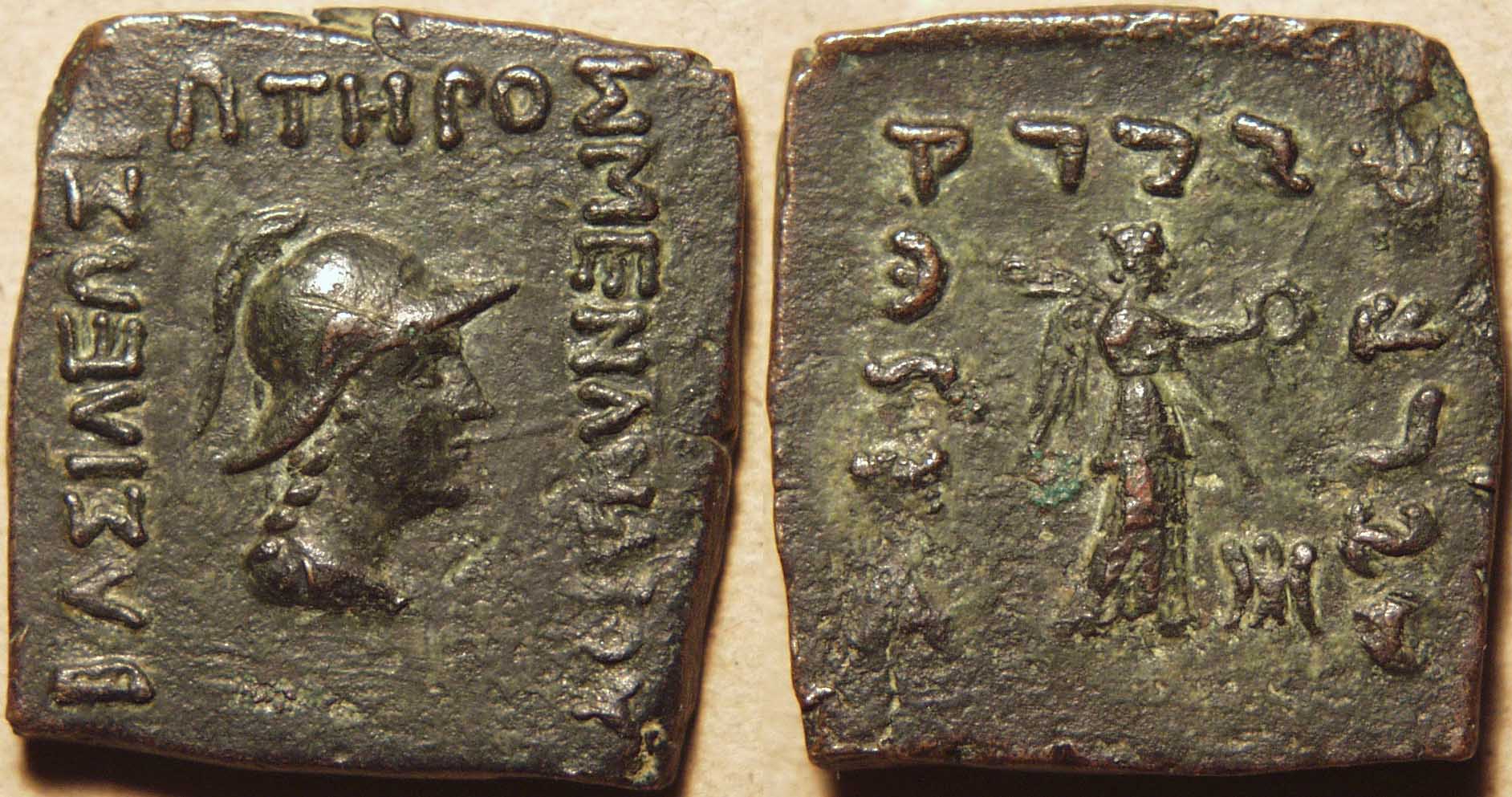
|
Menander I, Bronze Quadruple
Weight: 9.61 gm. Dimensions: 22 x 23 mm Die axis: 12h
Helmeted bust of Athena right,
Greek legend on three sides: BAΣIΛEΩΣ ΣΩTHPOΣ MENANΔPOY
Winged Nike standing right, holding wreath and palm,
Kharoshthi legend on three sides: maharajasa tratarasa / menamdrasa
Reference: MIG 243c, Bop 32G
|
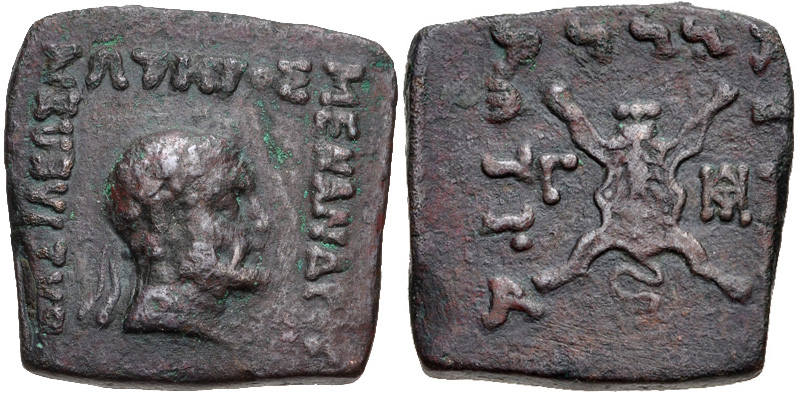
|
Menander I, Bronze Quadruple
Weight: 8.38 gm. Dimensions: 22 x 22 mm Die axis: 12h
Head of Hercules right,
Greek legend on three sides: BAΣIΛEΩΣ ΣΩTHPOΣ MENANΔPOY
Lion skin, monogram at right, Γ at left,
Kharoshthi legend on three sides: maharajasa tratarasa menamdrasa
Reference: MIG --- (248 for type), Bop --- (35 for type), CNG e250 lot 192
|
 |
A previously unpublished type that appeared in a recent CNG auction. There is one known coin with these designs of
head of Hercules and lion-skin, but that coin carries only the monogram on the reverse. This coin also carries the Greek letter Γ (gamma, the third
letter in the Greek alphabet). In light of the coins with letters A, B and Δ representing denominations, one wonders if this coin is meant to be triple unit
(hence the use of the third letter). (photo courtesy CNG)
|

|
Menander I, Bronze Quadruple
Weight: 6.92 gm. Dimensions: 23 x 22 mm Die axis: 12h
Head of Hercules right,
Greek legend on three sides: BAΣIΛEΩΣ ΣΩTHPOΣ MENANΔPOY
Lion skin, monogram at right,
Kharoshthi legend on three sides: maharajasa tratarasa menamdrasa
Reference: MIG 248, Bop 35
|
 |
The previous coin had been written up and included on this page before I was fortunate enough to acquire this coin,
apparently the second known specimen of the type, and much nicer than the example listed by Mitchiner and Bopearachchi.
|
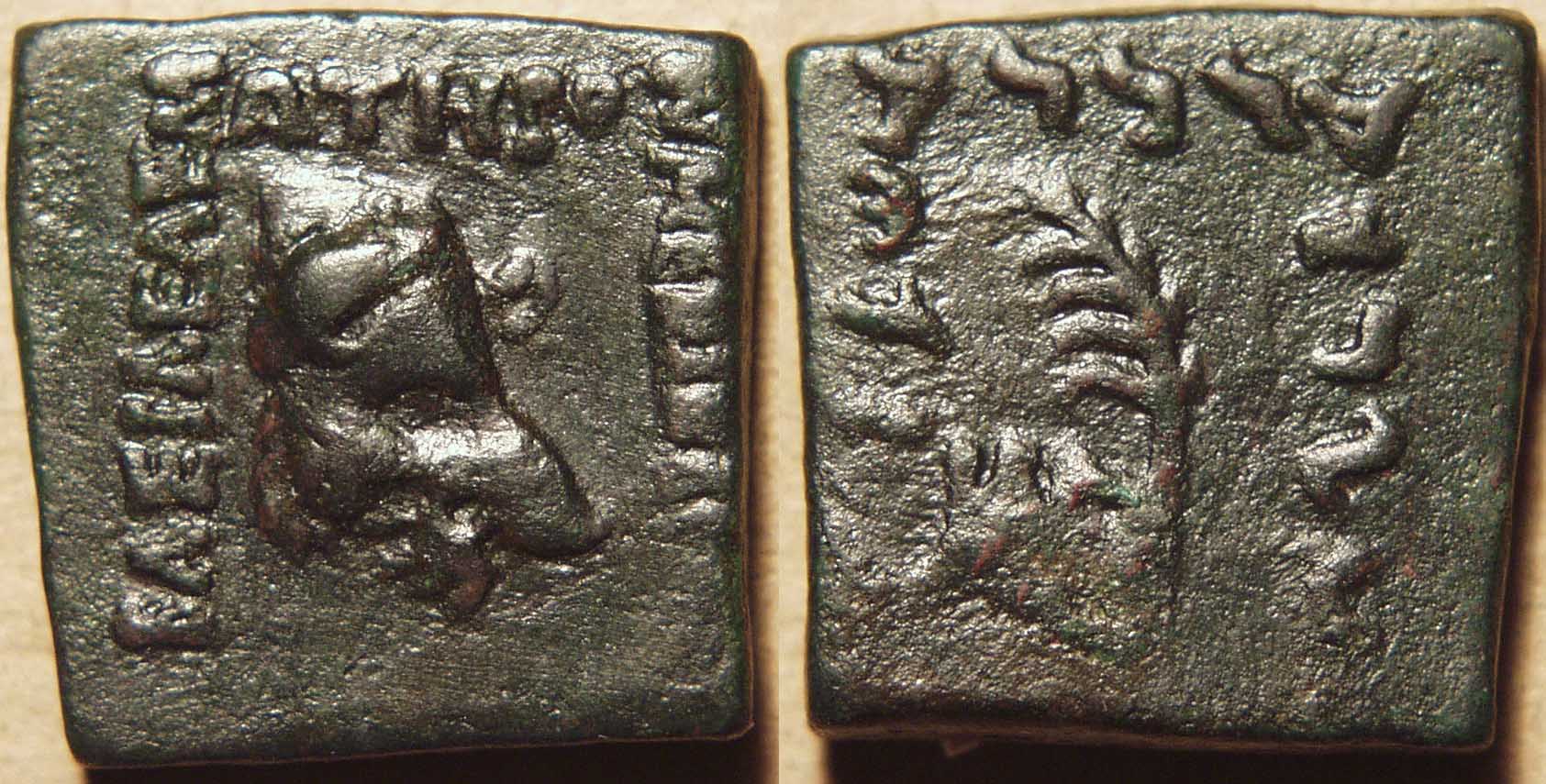
|
Menander I, Bronze Quadruple
Weight: 10.18 gm. Dimensions: 20 x 20 mm Die axis: 12h
Head of boar right,
Greek legend on three sides: BAΣIΛEΩΣ ΣΩTHPOΣ MENANΔPOY
Palm branch, monogram at left,
Kharoshthi legend on three sides: maharajasa tratarasa menamdrasa
Reference: MIG 249a, Bop 36A
|
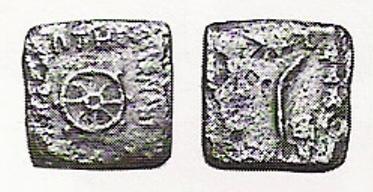
|
Menander I, Bronze Half unit
Weight: 1.57 gm. Dimensions: 12 x 12 mm Die axis: 12h
Eight-spoke wheel (dharmachakra),
Greek legend on three sides: BAΣIΛEΩΣ ΣΩTHPOΣ MENANΔPOY
Palm branch, monogram at right,
Kharoshthi legend on three sides: maharajasa tratarasa menamdrasa
Reference: MIG 241a, Bop 37A
|
 |
Only one specimen of this coin is known; it resides in the British Museum. This type is the only coin of Menander that
has an explicit Buddhist theme. Its extreme rarity is why I feel Menander never actually adopted Buddhism ... the coins are the only specific, tangible evidence
we have of his reign and they do not exhibit (except for this unique coin) any Buddhist influence. (photo courtesy Wikipedia)
|
 |
 |
 |
Sealing |
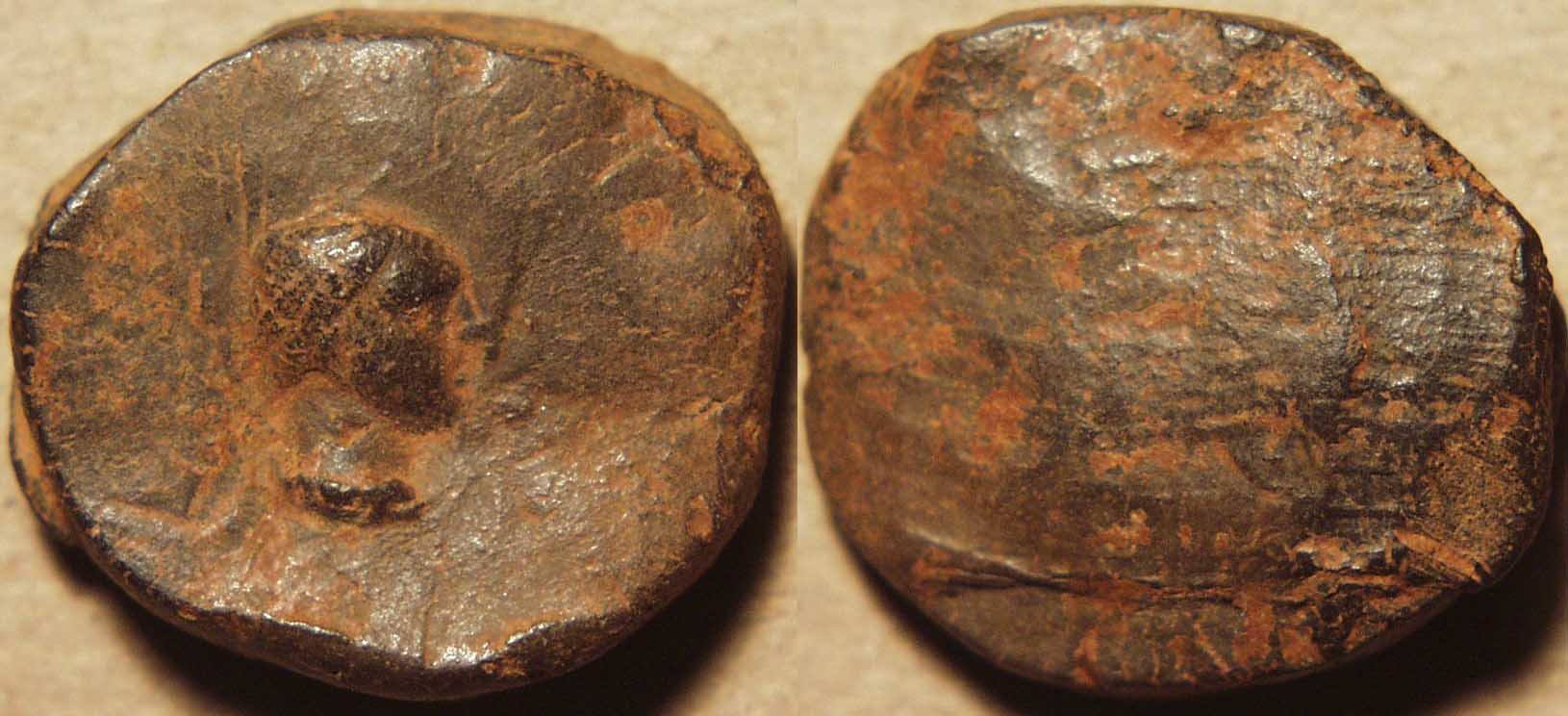
|
Menander I ?, Clay sealing
Weight: 2.02 gm. Diameter: 20 mm Die axis: na
Diademed head of king right
Blank
|
 |
A clay sealing with a king's head ... nothing to prove whose this is, but there is a superficial resemblance to the
portraits of Menander, so it may well be his.
|
|
|